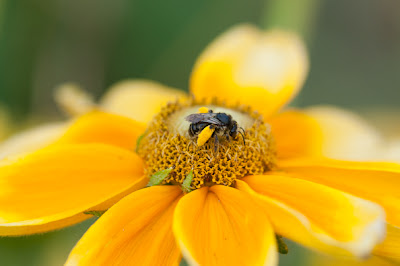When I took the dog out a few minutes ago, it hit me. Adrift through this warmish September night, misty almost with high humidity, is the overpowering fragrance of goldenrod honey-in-the-making, a smell only a beekeeper can appreciate. If someone was strolling in our yard who was not familiar with the emanations from beehives at this time of year, they might be holding their nose and wondering where a pile of stinky gym clothes was moldering, and why. Similarly described as sweaty socks, this odor can only be called fetid and is as unpleasant as one only a locker room full of well-worked-out athletes-pre-showering might provide. Yipes. From the smell in our yard, even at quite a distance from the hives and at night, our three honeybee hives must be filling with goldenrod nectar.
There are about 20 species of goldenrods in Maine that bloom from mid-summer into October. Some are tall and bushy, others are short and spikey. Some people claim that eating goldenrod honey helps decrease allergic reactions to the plant's pollen. Another theory suggests that it is not goldenrod but rather ragweed that blooms around the same time that is the real culprit in allergy attacks. Whatever the case, since becoming a beekeeper, I have transplanted goldenrod plants around our yard and leave any that volunteer in the vegetable garden. They do tend to be large and sprawly when growing in more fertile ground.
Being a beekeeper and having an interest in bees in general can change the way one not only chooses what plants to grow but also what to pull up as weeds !
Obviously you can't photograph a smell, but fragrance plays a role in attracting pollinators, so, the insects that visit the goldenrod are in a way evidencing the fragrance. But only our heroine, the honeybee concentrates the nectar in her hive to such an extent that it can perfume the neighborhood!
The following photographs were made on the same day, on the same plant, showing some of the varieties of pollinators on this important plant species... goldenrod!
 |
| Bumblebee |
 |
| Wasp - yellow jacket |
 |
| Unidentified native bee |
 |
| Another wasp species |
 |
| Yet another wasp species |
 |
| Honeybee moving between blossoms |














